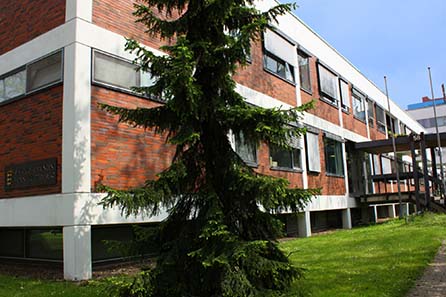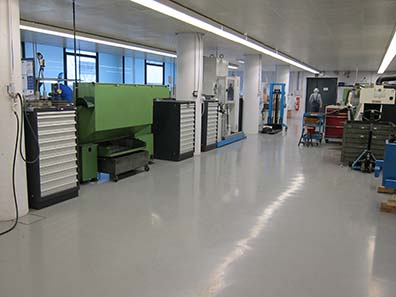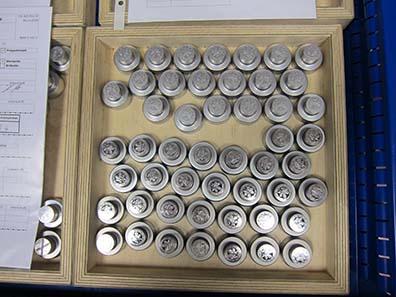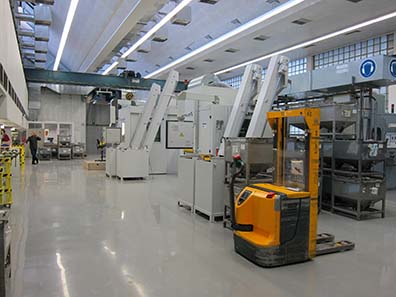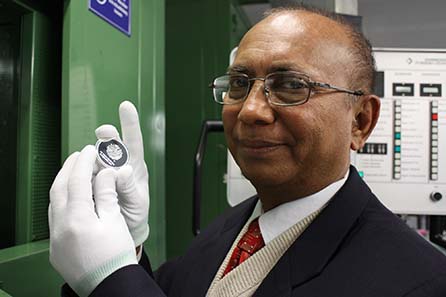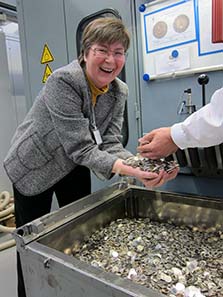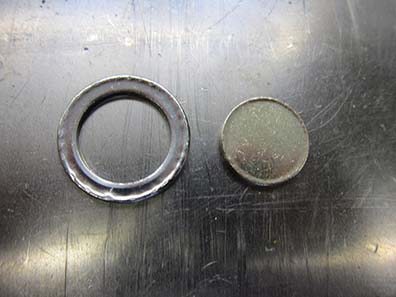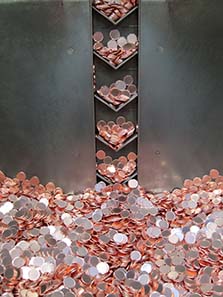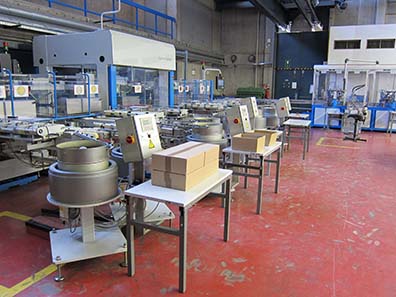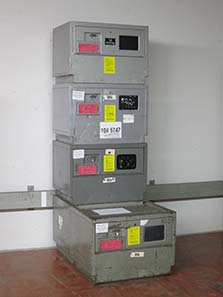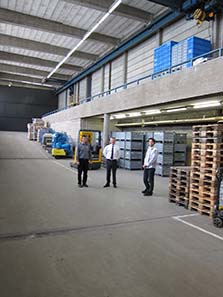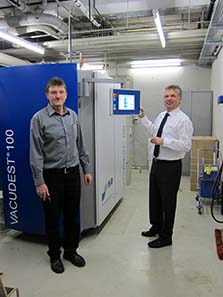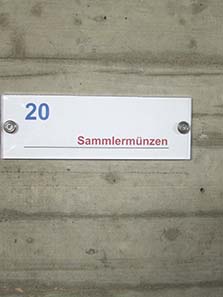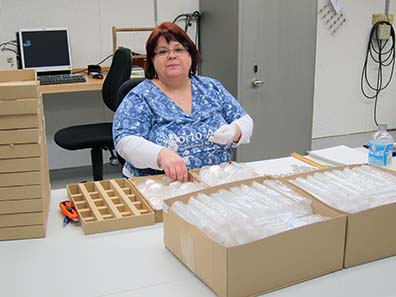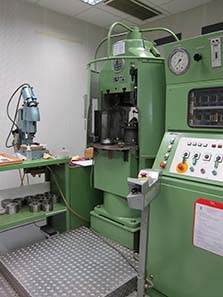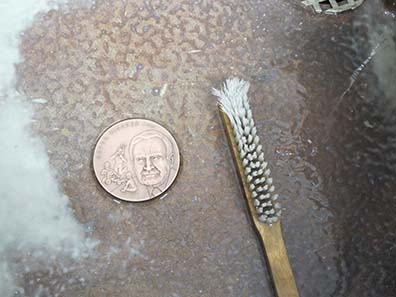June 16, 2011 – CoinsWeekly received an invitation for a visit to the Stuttgart Mint. We needn’t be asked twice. After all, that mint, which is identified by the F mark on German coins, has a tradition that goes back more than 600 years. It was in 1374 that Charles IV granted Eberhard II, Count of Wuerttemberg, the right to of mint coins.
The Stuttgart Mint from outside. Photograph: State Mint of Baden-Wuerttemberg.
Since 1967, The Stuttgart Mint is situated in a modern building in the Bad Cannstatt, a district of Stuttgart. Anyone interested in visiting the mint is required to show his ID card and to remove any hard cash from his pockets. Anyone leaving the building – whether director or apprentice –, gets checked.
This is where the punches are made. Photograph: UK.
The visitor walking the production halls soon forgets that he is inside a metalworking industrial facility. The clean, bright floors rather recall high-tech than heavy machinery.
Minting coins requires a great number of completely identical minting tools. Photograph: UK.
It really is high-tech: amongst colleagues, the Stuttgart Mint has acquired a reputation as innovative enterprise. Latest technology is applied here, for example the direct hobbing method, invented by the Sack & Kiesselbach Company. In a relative short period of time, many completely identical minting tools, needed in the minting production as punches, can be produced that way.
Coining room – this is where the German circulation coins are produced. Photograph: UK.
The State Mints of Baden-Wurttemberg, Stuttgart and Karlsruhe, combined to one joint enterprise, produce roughly 38% of German circulation coins and 40% of German collectors coins, added by orders of other states and a medal program.
The Director of the Central Bank of Bangladesh is pleased with the commemorative coins minted in Stuttgart. Photograph: Nico Leithoff.
To state one example: Stuttgart produced the commemorative coins issued on the occasion of the 10. CC Cricket World Cup 2011.
A windfall. The author Ursula Kampmann enjoys acting like Scrooge McDuck for once. Photograph: Nico Leithoff.
38 % of all German circulation coins – it comes as no surprise, then, that state-of the-art coining machines are required for such numbers. By using Schuler presses MRV and MRH 150, the Stuttgart Mint is able to manufacture 750 circulation coins up to the 2 Euro piece per minute (!). That adds up to 360.000 pieces in eight hours.
Perimeter and interior are joined together only when the minting takes place. Photograph: UK.
Such high numbers are necessary. After all, in 2010 the Stuttgart Mint manufactured the following dimension of circulation coins alone: 113,280,000 1 Cent pieces, 87,360,000 2 Cent pieces, 47,760,000 5 Cent pieces, 29,280,000 20 Cent pieces and 23,520,000 2 Euro pieces – that adds up to approximately 188 million circulation coins!
A lift to transport the planchets to the coining press. Photograph: UK.
Of course, all possibilities are exploited to accelerate the proceeding, like a lift to transport the planchets to the coininh press.
A semi-automatic packaging facility. Photograph: UK.
The packaging likewise is done semi-automatically.
Money by the box. Photograph: UK.
The supply of coins is stored in huge boxes in especially secured strong rooms before they are delivered to the German Central Bank.
Coins can be loaded within the building here. Photograph: UK.
To ensure the biggest safety possible, the loading of the secured transport of valuables takes place within the building. The trucks can drive into the mint. The inner area of it, however, is not accessible to the drivers.
A water treatment plant; to the right Peter Preuss, Production Manager Stuttgart and Karlsruhe; to the left Dr Peter Huber, Director of the State Mints of Baden-Wuerttemberg. Photograph: UK.
Of course, the protection of the environment is a priority with Stuttgart, too. When the round blanks are cleaned, for example, large amounts of water are consumed. A vacuum distillation plant treats that water and removes all pollution and remaining metal so that the water can be used again for cleaning the next round blanks. That saves a lot of fresh water.
The department for collectors coins. Photograph: UK.
Access to the department of collectors coins.
125th anniversary of the automobile: commemorative coin in silver. Photograph: UK.
Long before the commemorative coins are issued, they are prepared for the collectors.
The packaging takes place. Photograph: UK.
Every single piece is put into the slab manually and with great care.
This is a coining press specially equipped to produce an especially high relief from the Sack and Kiesselbach Company.
The Stuttgart Mint brought up a very ambitious program of medals which, thanks to sophisticated technology, exhibit a remarkably high relief only rarely witnessed with modern medals.
Manual patinating. Photograph: UK.
As was common in the 19th century, the patina is applied manually.
In 2006, the Stuttgart Mint won the German-wide “Land of Ideas” Competition. Thus, the subject of the series of medals goes nicely with the “Musterländle” (“model state”), the State Mints of Baden-Wuerttemberg and the German top output which appears in a rather modest guise. It is entitled “Erfinder und Tüftler aus Baden-Württemberg“ (“Inventors and Innovators from Baden-Wuerttemberg”) and is devoted to people who changed the world with their inventions. Karl Drais, who invented the bicycle, Artur Fischer, who revolutionized private photography with his flashlight and DIY with his Fisher dowel, or the constructer Karl Maybach – they all belong to the big tradition the Stuttgart Mint is a part of, too.
by Ursula Kampmann
If you like to find out more about the Stuttgart Mint please click here.
Here you can book a guided tour around the State Mints of Baden-Wuerttemberg and view a small film about the coin production.
You can go directly to the series of art medals “Erfinder und Tüftler aus Baden-Württemberg“ (available in German only).





